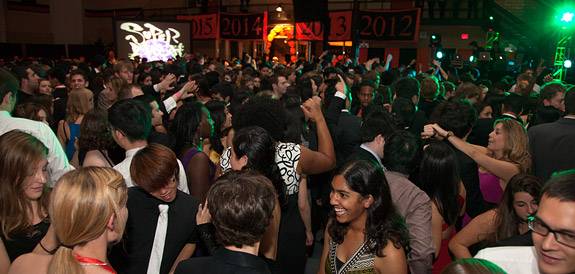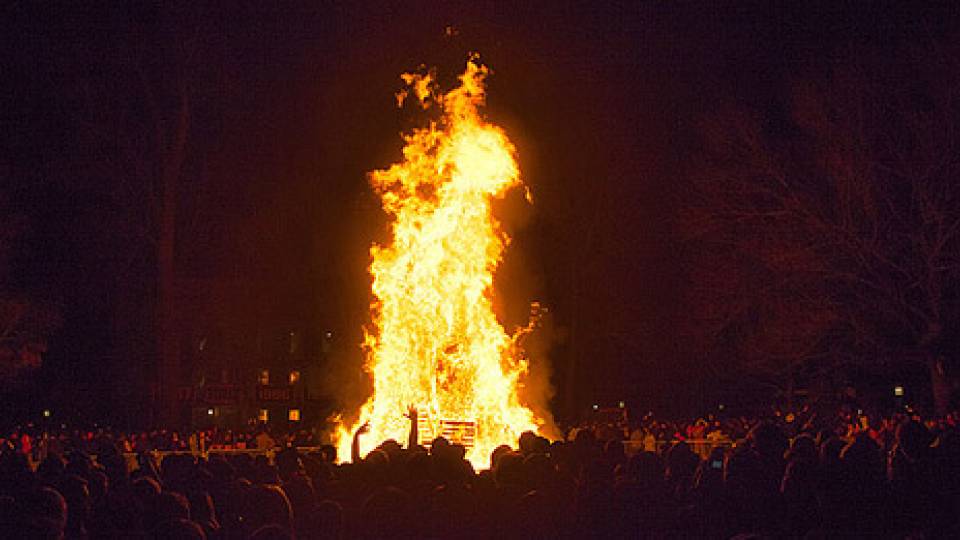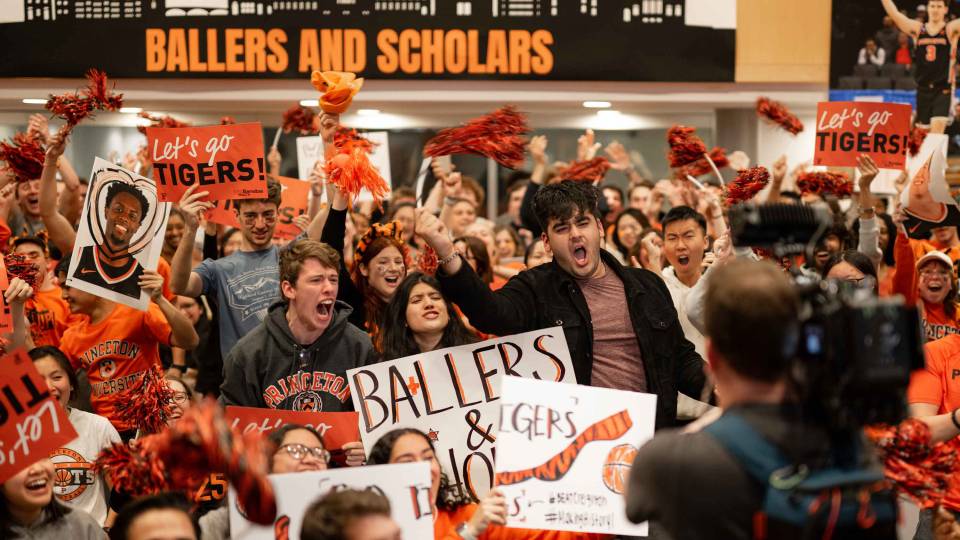After more than eight months of planning, Princeton University held its first Orange and Black Ball since the 1960s in Dillon Gym Friday, Nov. 11. Held on homecoming weekend, the event, which had sold out of approximately 3,000 tickets on Wednesday afternoon, was thrown to bring together the campuswide community in an all-inclusive night of entertainment.
At the ball, students dressed in formal attire took pictures, ate food, drank non-alcoholic beverages and danced to live music. The headline act of the night was Super Mash Bros., a popular choice among students, many of whom had seen the performers at the University’s 2010 fall Lawnparties hosted by the eating clubs.

The Orange and Black Ball, held in Dillon Gym Friday, Nov. 11, brought students together for dancing and fun. The event was organized by students to create an all-inclusive social event on campus. (Photo by John Jameson)
“At first I was skeptical about having it in Dillon, but it’s actually better than expected. If you like dancing, this is your kind of place,” said freshman Amber Stewart.
The main student organizers of the event, Stefan Kende, Tulio Alvarez Burgos, Zachary Beecher, Jamie Joseph and Mary D’Onofrio — who hold the class leadership positions of 2013 vice president, 2012 social chair, 2013 president, 2013 social chair and 2014 secretary, respectively — initially had conceived the idea of the ball last February.
Their goal was to revive a Princeton tradition, previously known as the Prince-Tiger Ball, which had languished for more than 50 years. The efforts of the student organizers were further spurred by the findings of the Working Group on Campus Social and Residential Life(Link is external), which issued a report in May this year recommending that the University hold more campuswide social events. Embracing the idea of creating more large-scale social events that gathered together the four undergraduate classes, the student organizers resolved to make the ball a reality.
“Even though everybody thought it was a good idea, we didn’t really pick it up until those recommendations came out — just because that gave us a metric against which we could measure the success and the popularity of the ball,” D’Onofrio said. “While the working group’s recommendations did set the plans for the ball in motion by demonstrating the University’s need for nonselective social events, the two were initially unrelated.”
Beecher said that the idea to revive the historic event originated at one of the class governments’ upperclass officer meetings in which Thomas Dunne, associate dean in the Office of the Dean of Undergraduate Students (ODUS), suggested that the group look toward past University traditions for ideas for future social events. Joseph Ramirez, program coordinator at ODUS, and Dianne Spatafore, director of Campus Cub, also played a crucial role in organizing the event.

An estimated 3,000 students attended the ball, with ample opportunity for dancing. The ball revived a previous annual event not held on campus since the late 1960s. (Photo by John Jameson)
The student organizers found their example in the original ball, which was an annual dance held in the 1950s and ’60s for the entire student body thrown by the Daily Princetonian and TigerMag — the University’s two major student publications at the time — on the weekend of the Princeton-Yale football game. The ball was discontinued in 1967 due to lack of student interest and various cultural conflicts surrounding the Vietnam War.
“The Orange and Black Ball — from the Prince-Tiger Ball — was one of the ideas that really jumped off the page,” Beecher said. “I don’t think we had ever considered the idea what the class governments’ roles in a campuswide, school-unity kind of event was. That’s always been something referred to the USG [Undergraduate Student Government].”
“I think it’s a unique opportunity for the entirety of the student body to come together in a way that’s not already brought by Lawnparties and the dodgeball tournaments,” D’Onofio said. “One of the big callings was for a concert. Another was for and all-school dance. Another was just for an all-school event. This seemed to be the perfect amalgamation of the three — dressing up, getting together, taking pictures and creating a memory.”

The ball offered a new opportunity for students to gather for large-scale entertainment, while catching up with friends from across the class years. (Photo by John Jameson)
At the ball itself, students gave a great deal of positive feedback about the sense of unity that the ball promoted. “What attracted me to the ball was getting to see all the people that I don’t really get to see — people from FSI [Freshman Scholars Institute], Community Action and the friends that I’ve made on The Street — from all class years in one place,” said Stewart.
Another student, sophomore Minerva Pedroza, noted that the dancefloor was “really sweaty,” and that, despite the large crowd, there was “a lot of unused open space.”
Overall, Kende said that he and the other student organizers would see the event as a success if students wanted to have it again next year.
According to junior Olivia Guayasamin, the ball was a definite success. “Sometimes, there can be a sense of monotony about The Street — the ball was to get people excited, and it’s hard for students to get excited anymore,” she said. “I definitely think there should be another ball next year, maybe with a theme. It’s something special. Something different.”
According to the student organizers, the timing of the event was also crucial for their choice to hold the ball. “It’s hard to plan such a big event and pick a weekend,” said Alvarez Burgos. “You are very likely to pick an event where half the student body is busy doing something. The fact that it’s during homecoming weekend … it makes it a weekend event. You go to the Orange and Black Ball, then the next day you go to the game.”





